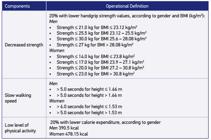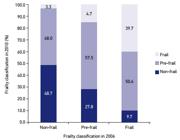ABSTRACT:
Introduction:
Frailty is a preventable and reversible syndrome characterized by a cumulative decline of physiological systems, causing greater vulnerability to adverse conditions.
Objective:
To describe the prevalence of frailty among older adults and analyze its associated factors and progression.
Method:
This is a longitudinal study that used the Health, Well-being, and Aging Study (Saúde, Bem-Estar e Envelhecimento - SABE) database of 2006 and 2010. Five components identified the frailty syndrome: weight loss; fatigue; decreased strength, low physical activity, and reduced walking speed. Older adults were classified as “pre-frail” (1-2 components) and “frail” (3 or more). We used a hierarchical multiple multinomial regression to analyze associated factors.
Results:
Out of the total number of older adults (n = 1,399), 8.5% were frail, and the associated factors were age, functional impairment, cognitive decline, hospitalization, and multimorbidity. In four years, 3.3% of non-frail and 14.7% of pre-frail older adults became frail.
Conclusion:
Identifying the prevalence of frailty and its associated factors can help to implement adequate interventions early to improve the quality of life of older adults.
Keywords:
Aged. Aged; 80 and over. Frail elderly
 Thumbnail
Thumbnail
 Thumbnail
Thumbnail
 Thumbnail
Thumbnail
 Thumbnail
Thumbnail



 Source: SABE Study, 2006-2010.
Source: SABE Study, 2006-2010.